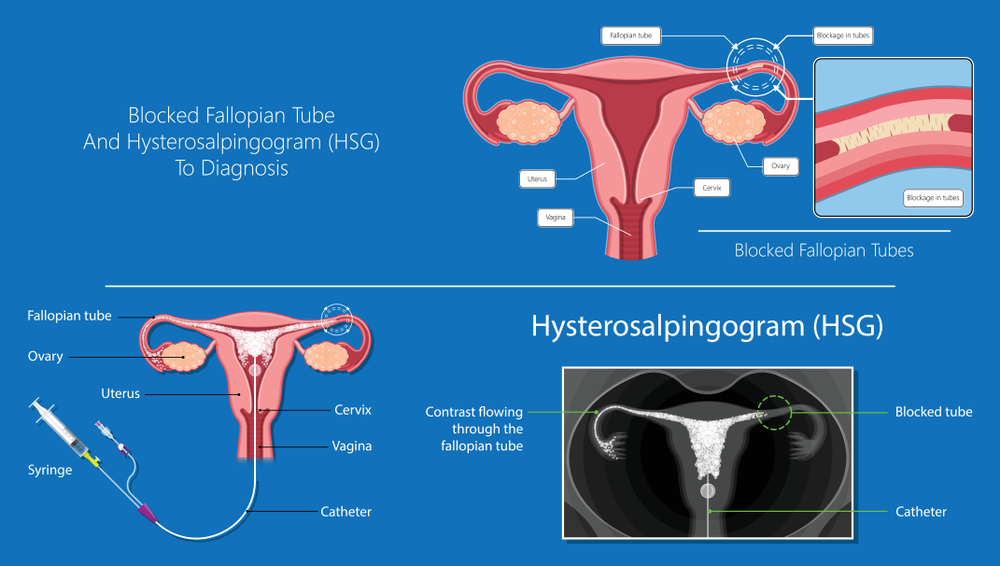Everything you need to know about the HSG test
The Hysterosalpingography (HSG) test is a specialized medical procedure used to assess a woman’s reproductive health. It provides detailed X-ray images of the uterus and fallopian tubes, which help doctors identify any structural issues, blockages, or abnormalities that might affect fertility. The HSG diagnostic test plays a crucial role in evaluating potential causes of infertility or recurrent miscarriages, offering insights into whether the fallopian tubes are open and if the uterus has a normal shape.
This test is often recommended for women who are struggling to conceive, as it helps doctors determine if there are any physical barriers preventing pregnancy. The HSG test is a quick outpatient procedure, meaning it doesn’t require an overnight hospital stay, and results are typically available soon after the test.

What Is the HSG Test?
The HSG diagnostic test is an X-ray test used to look inside a woman’s reproductive organs. During the test, a special dye is injected into the uterus through the cervix. This dye helps the doctor see the uterus and fallopian tubes more clearly on the X-ray images. If the dye flows freely through the fallopian tubes and into the abdominal cavity, it indicates that the tubes are not blocked. However, if the dye cannot pass through, there may be a blockage that could impact fertility.
Why Is the HSG Test Done?
Doctors recommend the HSG test for several reasons:
- To check for blockages in the fallopian tubes, which can prevent eggs from meeting sperm, leading to infertility.
- To assess the shape and size of the uterus. Any abnormalities in the uterine shape may increase the risk of miscarriage or affect fertility.
- As part of the fertility workup for women who are struggling to conceive.
- To investigate potential causes of repeated miscarriages.
The Procedure: What to Expect
The HSG test is usually performed in a hospital or clinic by a radiologist or gynecologist. Here’s a step-by-step breakdown of the procedure:
- Preparation: The patient lies down on an X-ray table. A speculum (the same instrument used during a Pap smear) is inserted into the vagina to allow the doctor to access the cervix.
- Dye Injection: A thin tube is inserted into the cervix, and the dye is gently injected into the uterus. This may cause mild cramping, similar to menstrual cramps.
- X-ray Imaging: As the dye moves through the uterus and fallopian tubes, X-rays are taken to capture images. The doctor will analyze these images to check for blockages or abnormalities.
Completion: Once the images are taken, the procedure is complete. The entire process usually takes about 30 minutes.
Is the HSG Test Painful?
Many women are concerned about the discomfort associated with the HSG test. While the procedure can cause mild to moderate cramping, it is generally quick and manageable. If you’re particularly concerned about pain, you can ask your doctor about a painless HSG test in Kolkata, where clinics offer options for reducing discomfort during the procedure.
HSG Test in Kolkata: Where to Get It Done
If you’re looking for an HSG test in Kolkata, there are many reputable hospitals and diagnostic centers that offer this service. These clinics have experienced radiologists and gynecologists who can ensure the test is performed safely and efficiently. You can also inquire about options for a painless HSG test in Kolkata if you’re worried about discomfort.
How to Prepare for the HSG Test
Before the HSG test, your doctor may give you specific instructions to follow:
- Timing: The HSG test is usually scheduled after your period but before ovulation (usually between days 5-10 of your menstrual cycle) to ensure that you are not pregnant during the test.
- Medication: Your doctor may suggest taking a pain reliever like ibuprofen 30-60 minutes before the test to minimize cramping.
Allergies: Inform your doctor if you have any allergies, especially to iodine or contrast dye, as these are used during the test.
What Are the Risks?
Like any medical procedure, the HSG test carries some risks, but they are rare. Possible complications include:
- Infection: There is a slight risk of infection after the test, but this can usually be treated with antibiotics.
- Allergic Reaction: If you’re allergic to iodine, you may experience a reaction to the dye used during the test. Inform your doctor about any known allergies in advance.
Spotting: Some women experience light bleeding or spotting after the procedure, which is normal and typically resolves quickly.
After the Test: What to Expect
After the HSG test, most women can return to their normal activities. Some cramping or light spotting may occur, but these symptoms should go away within a day or two. If you experience heavy bleeding, fever, or severe pain, contact your doctor immediately.
Conclusion
The HSG diagnostic test is a valuable tool for diagnosing issues related to fertility. Whether you’re investigating potential causes of infertility or recurrent miscarriages, this test can provide important insights into the health of your uterus and fallopian tubes.If you’re in Kolkata and need to undergo this test, there are several clinics that offer both standard and painless HSG tests in Kolkata options. Always consult with your doctor to ensure you receive the best care possible.

.png) (+91) 9864103333
(+91) 9864103333 (+91) 9435502020
(+91) 9435502020



